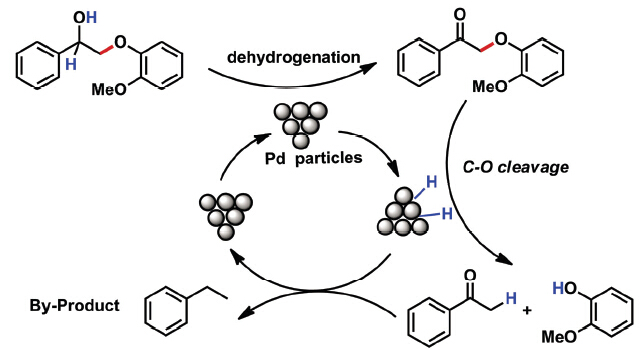| [1] Holdren, J. P. Science 2007, 315, 737.
[2] (a) Vispute, T. P.; Zhang, H.; Sanna, A.; Xiao, R.; Huber, G. W. Science 2010, 330, 1222.
(b) Crossley, S.; Faria, J.; Shen, M.; Resasco, D. E. Science 2010, 327, 68.
(c) Zhang, Y. H. P. J. Ind. Microbiol. Biotechnol. 2008, 35, 367.
[3] (a) Regalbuto, J. R. Science 2009, 325, 822.
(b) Holm, M. S.; Saravanamurugan, S.; Taarning, E. Science 2010, 328, 602.
(c) Luo, C.; Wang, S.; Liu, H. Angew. Chem. Int. Ed. 2007, 46, 7636.
(d) Mascal, M.; Nikitin, E. B. Angew. Chem. Int. Ed. 2008, 120, 8042.
(e) Ragauskas, A. J.; Williams, C. K.; Davison, B. H.; Britovsek, G.; Cairney, J.; Eckert, C. A.; Frederick, Jr. W. J.; Hallett, J. P.; Leak, D. J.; Liotta, C. L.; Mielenz, J. R.; Murphy, R.; Templer, R.; Tschaplinski, T. Science 2006, 311, 484.
[4] Zakzeski, J.; Bruijnincx, P. C.; Jongerius, A. L.; Weckhuysen, B. M. Chem. Rev. 2010, 110, 3552.
[5] Chakar, F. S.; Ragauskas, A. J. Ind. Crops Prod. 2004, 20, 131.
[6] Balakshin, M. Y.; Capanema, E. A.; Chang, H. M. Characterization of Lignocellulosic Materials, Blackwell Publishing Ltd., Oxford, UK, 2008, p. 148.
[7] (a) Wang, X.; Rinaldi, R. Angew. Chem. Int. Ed. 2013, 52, 11499.
(b) Wang, X.; Rinaldi, R. ChemSusChem 2012, 5, 1455.
(c) Wang, X.; Rinaldi, R. Energy Environ. Sci. 2012, 5, 8244.
[8] (a) Sergeev, A. G.; Hartwig, J. F. Science 2011, 332, 439.
(b) Sergeev, A. G.; Webb, J. D.; Hartwig, J. F. J. Am. Chem. Soc. 2012, 134, 20226.
[9] (a) He, J.; Zhao, C.; Lercher, J. A. J. Am Chem Soc. 2012, 134, 20768.
(b) Yan, N.; Zhao, C.; Dyson, P. J.; Wang, C.; Liu, L. T.; Kou, Y. ChemSusChem 2008, 1, 626.
(c) Zhao, C.; Lercher, J. A. ChemCatChem 2012, 4, 64.
(d) Zhao, C.; Lercher, J. A. Angew. Chem. Int. Ed. 2012, 124, 6037.
[10] (a) Zhao, C.; Kou, Y.; Lemonidou, A. A.; Li, X.; Lercher, J. A. Angew. Chem. Int. Ed. 2009, 121, 4047.
(b) Yan, N.; Zhao, C.; Dyson, P. J.; Wang, C.; Liu, L. T.; Kou, Y. ChemSusChem 2008, 1, 626.
(c) Yan, N.; Yuan, Y.; Dykeman, R.; Kou, Y.; Dyson, P. J. Angew. Chem. Int. Ed. 2010, 49, 5549.
[11] Zhang, Q. S.; Wang, L. L. J. Mol. Catal (China) 2013, 27, 89. (张勤生, 王来来, 分子催化, 2013, 27, 89.)
[12] Li, G. X.; Dong, P.; Wang, X. R.; Xu, Y. D.; Wang, C. J.; Liu, Y. J. Mol. Catal (China) 2012, 26, 26. (李贵贤, 董鹏, 王小瑞, 徐彦铎, 王成君, 刘扬, 分子催化, 2012, 26, 26.)
[13] Liang, K. Ph.D. Dissertation, University of Lanzhou, Lanzhou, 2008. (梁琨, 博士论文, 兰州大学, 兰州, 2008.)
[14] Liu, L. T.; Zhang, B.; Li, J.; Ma, D.; Kou, Y. Acta Phys.-Chim. Sin. 2012, 28, 2343. (刘凌涛, 张斌, 李晶, 马丁, 寇元, 物理化学学报, 2012, 28, 2343.)
[15] Song, Q.; Wang, F.; Cai, J.; Wang, Y.; Zhang, J.; Yu, W.; Xu, J. Energy Environ. Sci. 2013, 6, 994.
[16] Molinari, V.; Giordano, C.; Antonietti, M.; Esposito, D. J. Am. Chem. Soc. 2014, 136, 1758.
[17] Ren, Y. L.; Yan, M.; Wang, J. J.; Zhang, Z. C.; Yao, K. S. Angew. Chem. Int. Ed. 2013, 52, 12674.
[18] Kleine, T.; Buendia, J.; Bolm, C. Green Chem. 2013, 15, 160.
[19] Desnoyer, A. N.; Fartel, B.; MacLeod, K. C.; Patrick, B. O.; Smith, K. M. Organometallics 2012, 31, 7625.
[20] (a) Nguyen, J. D.; Matsuura, B. S.; Stephenson, C. R. J. J. Am. Chem. Soc. 2014, 136, 1218.
(b) Lian, Y. F.; Yan, L. L.; Wang, Y.; Qi, X. H. Acta Chim. Sinica 2014, 72, 502. (廉优芬, 闫碌碌, 王羽, 漆新华, 化学学报, 2014, 72, 502.)
[21] (a) Strassberger, Z.; Alberts, A. H.; Louwerse, M. J.; Tanase, S.; Rothenberg, G. Green Chem. 2013, 15, 768.
(b) Zhang, J.; Teo, J.; Chen, X.; Asakura, H.; Tanaka, T.; Teramura, K.; Yan, N. ACS Catal. 2014,4, 1574.
(c) Li, C.; Zheng, M.; Wang, A.; Zhang, T. Energy Environ. Sci. 2012, 5, 6383.
(d) Sturgeon, M. R.; O'Brien, M. H.; Ciesielski, P. N.; Katahira, R.; Kruger, J. S.; Chmely, S. C.; Hamlin, J.; Lawrence, K.; Glendon, B. Hunsinger, G. B.; Foust, T. D.; Baldwin, R. M.; Biddy, M. J.; Beckham G. T. Green Chem. 2014, 16, 824.
(e) Zhou, X.; Mitra, J.; Rauchfuss, T. B. ChemSusChem 2014, 7, 1623.
(f) Harms, R. G.; Markovits, I. I.; Drees, M.; Herrmann, W. A.; Cokoja, M.; Kühn, F. E. ChemSusChem 2014, 7, 429.
[22] Nichols, J. M.; Bishop, L. M.; Bergman, R. G.; Ellman, J. A. J. Am. Chem. Soc. 2010, 132, 12554.
[23] Guo, J. L.; Shen, Y. N. Chinese J. Inner Mongolia Normal University 2009, 38, 357. (郭金玲, 沈岳年, 内蒙古师范大学学报, 2009, 38, 357.)
[24] (a) Tanner, D.; Somfai, P. Tetrahedron 1987, 43, 4395.
(b) Jae, J.; Zheng, W.; Lobo, R. F.; Vlachos, D. G. ChemSusChem 2013, 6, 1158.
[25] Johnstone, R. A. W.; Wilby, A. H.; Entwistle, I. D. Chem. Rev. 1985, 85, 12.
[26] Huang, L.; Zhu, Y.; Huo, C.; Zheng, H.; Feng, G.; Zhang, C.; Li, Y. J. Mol. Catal. A: Chem. 2008, 288, 109.
[27] Zhang, T.; Tan, H. J.; Hong, Y. L.; Shen, L. J. Hangzhou Normal University (Nat. Sci. Ed.) 2012, 11, 7. (张添, 谭华杰, 洪益玲, 沈良, 杭州师范大学学报: 自然科学版, 2012, 11, 7.) |
